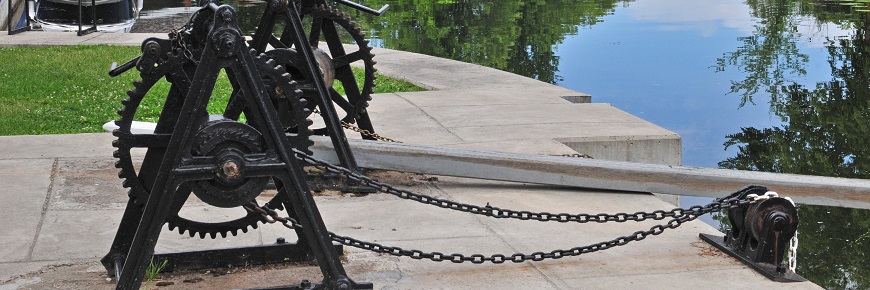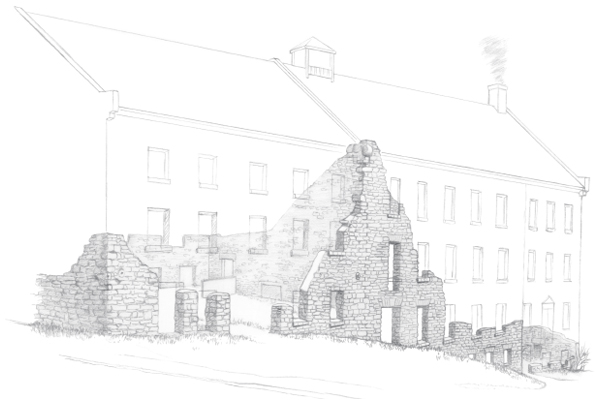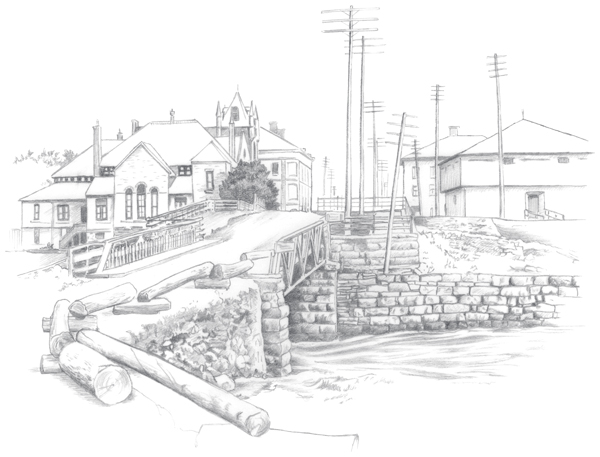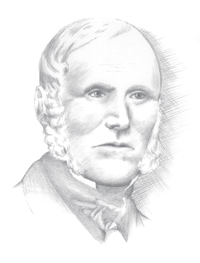
Merrickville Lockstation Walking Tour
Rideau Canal National Historic Site

William Merrick Sr. (1760-1844), arrived in the Merrickville area from Springfield, Massachusetts in 1793, after receiving a land grant of 200 acres for his “loyalty and good character”. He identified the waterpower potential of the site, constructed a dam across the Rideau River and built grist, saw and carding mills. A small community grew up around the mill site and it took the name of Merrick’s Mills. In 1800, it was linked to settlements on the St. Lawrence River not only by the Rideau River but also by a road to Brockville. The advantageous location at the confluence of a road and a river encouraged economic development, making Merrick’s Mills an important industrial and agricultural centre. By 1826, before canal construction began, Merrick’s Mills was already a thriving community of 300 people. A safe and navigable waterway would be a further boon to village merchants and industrialists to ship agricultural and industrial products to larger markets further away.

During the construction of the locks at Merrick’s Mills, Lt. Col. By went to great lengths to ensure that the grist and saw mills would not be destroyed by rising water levels. This endeavor slowed the pace of work and increased expenses. Unfortunately, in 1831, when the section of the canal from Bytown to Smiths Falls was ready to be opened, William Merrick decided to dam the Rideau River above Merrickville in order to make repairs to his mills. Because water levels were affected, Lt. Colonel By’s grand opening became impossible. Soon after, a new law was introduced that prevented unauthorized changes to the waterway.

Merrickville Blockhouse
The canal brought remarkable commercial and industrial development to Merrickville. Entrepreneurs expanded the wood, food processing, metallurgical and textile industries, quickly resulting in a trade triangle of barge traffic from Montreal to Ottawa to Kingston and on to larger markets such as the United States. Merrickville was fortunate not only to be in a prime location but also to have a skilled population of Scottish, British and Irish descent who were capable of developing the textile and metallurgical industries for which it became renowned.The area around Merrickville was rich in natural resources, especially timber, good soil, waterpower and minerals. An estimated 58 industries in Merrickville manufactured products by waterpower, from the earliest grist and saw mills to the first carding mill, established in 1817, the first woolen factory in 1848, first iron foundry in 1850 and other industries such as food processing, textile, metallurgical, wood processing and utilities.
Merrickville was the most important service centre between Bytown and Kingston. After the War of 1812, Lt. Colonel By and the Department of Ordnance were acutely aware of the possibility of future crisis with the United States. Even before construction of the canal, Merrickville was considered to be a logical target for an American invasion due to its proximity to the American border and location on a main artery from the St. Lawrence settlements. The result of this concern was the construction of a blockhouse at Merrickville in 1832-33.
The blockhouse, the second largest in Canada, is one of four existing on the Rideau Canal (and one of 20 planned) and is the largest defensible structure on the waterway. Its main purpose was to house troops to provide protection in Merrickville in the event of an attack. The blockhouse was built using rubble stone and limestone mortar. The walls are four feet thick at the base and taper to three feet thick towards the second story. The walls were designed to withstand cannon fire. The bottom section of the structure is separated from the top level by a floor made from timber and limestone infill. This was to protect troops on the top floor from gunfire if the enemy managed to breech the building. The roof was originally clad in tin, a fire-retardant material. There are cannon ports in the thick wall, as well as an upper gallery for shooting at the enemy from a safe position. The blockhouse had a drawbridge to increase its security and was surrounded by a dry moat. At 15.5 sq.m (51 sq. ft.) the blockhouse was large enough to accommodate 50 troops.
Like the Rideau Canal, the blockhouse was built for military purposes but saw very little action.
During the Rebellion of 1837-1838, a garrison of local militia was stationed at the blockhouse under the leadership of John Johnston, Royal Engineer, to defend Merrickville and the canal. For most of its history, the blockhouse served as a residence for Merrickville’s lockmasters and then as a storehouse. It also assumed the role of church and schoolhouse on occasion. It is now a museum managed by the Merrickville and District Historical Society.

Canal Builders
An estimated 2000 men worked on the construction of the canal at 20 work sites stretching from Ottawa to Kingston. About 50% of the workforce was Irish Protestant, mostly recent immigrants to Upper Canada; 40% were French Canadian Catholics from Eastern Ontario and Western Quebec; and 10% were of Scottish descent (mostly the skilled masons). In addition to civilian workers, Lt. Colonel By requested two corps of Royal Sappers and Miners (experts in explosives and earthworks), about 170 men in total. Although the Sappers and Miners were primarily engaged to protect work sites, keep the peace and supervise construction, they were also called upon to complete construction projects that were abandoned by contractors.
The canal labourers worked long days, 14 to 16 hours. They lived communally in large log houses built by contractors. Their diet consisted of salt pork, bread, biscuits, peas, beans and tea with some opportunity to buy fresh vegetables or eggs. The tools the workers had at their disposal to clear the land, and to carry out excavation, quarrying, and the hoisting of blocks of limestone into place, were primitive. The men used pick axes, felling axes, shovels and rudimentary pulleys to do the construction work. There were many hazards on the construction site. Falls from scaffolds and explosive accidents were just two of the many dangers that the workers encountered. In addition, there was the likelihood of contracting malaria along the Rideau River. The year 1828, for example, saw a serious outbreak of malaria that claimed many lives and halted work on the canal for six weeks. Of 2000 men who worked on the canal construction, 500 are said to have died from malaria. This figure does not include the wives and children of the Irish immigrants who often lived near the canal work sites.

After construction, many of the men who had worked on the canal were given positions as lockmasters. Thomas Newman, for example, had served with the Sappers and Miners under Sergeant John Johnston. In 1836, Newman became the second Lockmaster at Merrickville.
Related links
- Date modified :